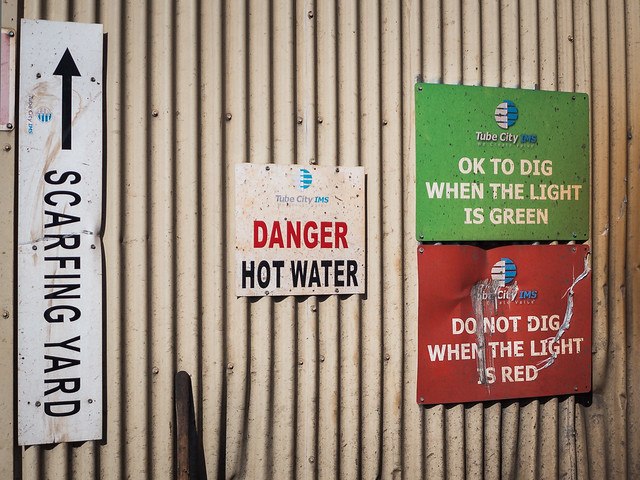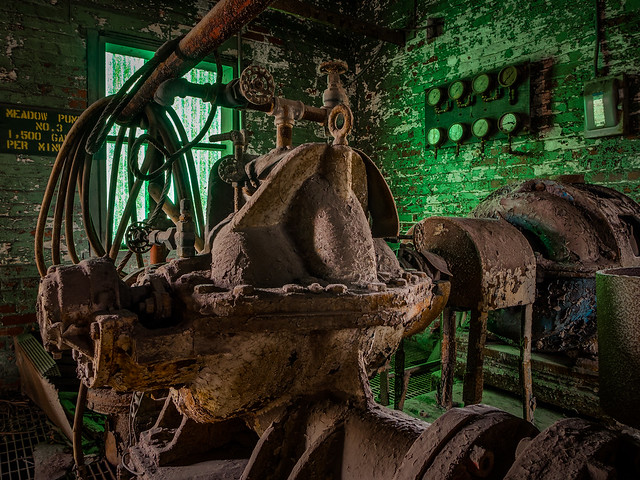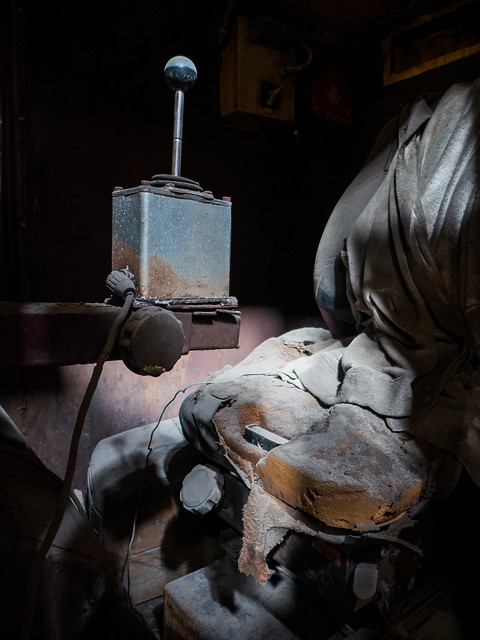Virtue in Downsizing: A Panasonic Lumix DMC-LX7 Compact Camera Review
"It is unfortunate, considering that enthusiasm moves the world, that so few enthusiasts can be trusted to
speak the truth." -- Arthur Balfour
Ladles Under Maintenance
4.7mm (24mm), f/1.4 @ 0.3 seconds ISO 80 (hand held HDR -- time is longest exposure)
Originally published March, 2013
Now whether Arthur is right or not I can't say. But I'm going to put up an "enthusiastic" user experience
review of the little Panasonic Lumix DMC-LX7 which I will refer to simply as the LX7 for all our sakes.
This means I'm not measuring anything -- I take pictures, show them to you, and tell you what I think about
using the camera. I shall endeavor to tell the truth!
I don't use out-of-camera jpg images. Some engineer or programmer that is very clever decides how the images should look and they are really good at it -- but they clearly don't know what I want MY images to look like or know how to deal with certain conditions to retain the most information -- at least without too many real-time adjustments to suit me. Sorry, I'm an "artiste", lol. So I shoot everything in RAW and process in Lightroom (version 4.4RC for these in this post).
What Is It and Why Did You Buy It?
The LX7 is the latest in a line of well thought of "enthusiast compacts" from Panasonic. The idea of such cameras is to provide decent (or even excellent) image quality in a package that allows a detail-oriented photographer to adjust the camera to suit. However, the camera has to have enough "guts" to deliver images beyond that of a normal "point-and-shoot".
Features such as exposure bracketing (for HDR for instance -- the opening shot is a 3 shot hand held HDR merge), fast shooting rates, and other features used by DLSR users are pretty common on these cameras. But they will surprise you with things that you might not expect.
Now I have a nice stable of micro four thirds cameras and lenses and they are so much smaller than my DSLR's were and I love them. They are capable of top notch quality.
But I wanted something even smaller for "concealed carry". My camera bag, even my smallest one, is at times a burden and too obvious. A camera that sits in a pocket or maybe a small belt pack brings additional possibilities. I don't like the kit lenses on my mft cameras (except the 12-50 for it's weather sealing -- but it's relatively huge) and they make the cameras too large to pocket even when retracted. Constantly changing primes slows things down so having the zoom (even the limited zoom) with fast aperture is really a great feature.

Can You Dig It?
9.8mm (50mm), f/1.9 @ 1/1000 second ISO 80 (hand held)
What Does the LX7 Bring to the Table?
Here's a brief list that is by no means complete.
- Shutter speeds from 1/4000 second to 250 seconds! The longest shutter speeds are available only in manual mode though. Still, it's great for dark rooms in abandoned buildings that require several minutes of exposure time.
- A 3.8x zoom lens that has a 24mm to 90mm equivalent range with f/1.4 available at 24mm and it only falls off to f/2.3 at 90mm. A surprisingly fast lens that enables lower light shooting than most compacts. Some want more zoom, but longer zoom ranges always degrade lens performance.
- Aperture adjustable from f/1.4 to f/8. Beyond f/8 you should use an ND filter because of diffraction -- hence the limit. The ND is built in and easily controlled.
- An actual aperture ring on the lens!
- 3-stop neutral density filter with a dedicated button to activate it (no menu needed)
- Manual focus toggle to control manual focus and automatic focus aid activation
- A real mode dial that is also stiff enough to not accidently move (are you listening Olympus?)
- Two programmable "memory" positions on the mode dial ("C1" and "C2") that can store complete camera setup. Makes it easy to go between (in my case) normal shooting and HDR brackets with auto ISO off. No menu, no fuss.
- 10 megapixel 1/1.7" sensor with fairly low noise (because of the lower resolution). That's a 5.1x crop factor compared to full frame 35mm and about 2.5x compared to micro four thirds so it's not a large sensor but larger than typical point-and-shoots.
- Aspect ratio switch on the lens and a special multi-aspect sensor retains about 10 megapixel resolution for all but the square format which is about 7.5 megapixels.
- An actual power switch
- Full 1080p video at high bit rates with stereo audio
- 1 button access for each of ISO, WB, and "Drive" mode.
- "QMENU" with quick access to most used functions
- Up to 3 stops per shot exposure bracketing (but only 3 shots)
- 10 frames per second shooting speed
- Fast autofocus (normal AF) and extended AF range for macro selectable by a dedicated switch on the lens barrel
- Multi-function control wheel (thumb wheel) on the rear panel that has a funny feel but is very usable.
- Low price point: Lists for $500 but is routinely on sale for $300 or less which is a great price for the LENS much less for a complete system that fits in your pocket (a largish pocket...)
Really, this camera has so much cool stuff you would be advised to have a look at a tech review like those at dpreview.com or steves-digicams.com or other technical review site. My pictures are better though...
How Does It Handle and How's the Quality
Excellent -- at least to me. There is no perfect camera for everyone and you might want to check out my blog post Photographers and Their Machines: Love Affair, Crutch, Or Prosthesis? where I discuss how a camera that "suits" you makes you a better photographer -- and a more enthusiastic one. It's not about the price of the camera or even the absolute quality. It's about how it makes you feel.

Open Arc Furnace
4.7mm (24mm), f/1.4 @ 1/10 second ISO 400 (hand held)
The shot above is at what I consider the "quality limit" for this camera, though ISO 800 is also really quite usable. If you go above that, you might not want to print it very large at all -- but with the f/1.4 lens it's amazing what you can get. It is NOT bright in the steel mill, yet I got this shot and it looks great -- and I was quite surprised by how good the quality was.
The cameras copious dedicated controls on the lens and the body are amazing. This camera already feels right and easy when I use it. It's a delight to a photographer like me.

Meadow Pump No. 3
4.7mm (24mm), f/2.8 @ 1/10 second ISO 80 (tripod HDR longest time)
The above shot is an example of the incredible clarity, color, and sharpness available from this little gem of a camera. At f/2.8 the lens is sharp all over and though I don't post full size images I can tell you I would have absolutely no problem with printing this at 16x20 inches. The quality is there.
How about a single exposure low light shot?

Dead Stick
4.7mm (24mm), f/1.4 @ 1 second ISO 80 (tripod mounted)
Dead Stick was taken in the operators cab for a large robotic arm that wielded a huge torch to condition the surface of heavy steel slabs -- an operation called "scarfing". The robot came to the end of its useful life and was abandoned. The building is not open on this side, the light is low and coming through holes in the rotten sheeting on the walls.

Even Robots Get the Blues
4.7mm (24mm), f/2.8 @ 1/80 second ISO 80 (tripod HDR longest time)
Above is the robot arm, stripped of its hydraulic muscles and skin... a pitiful skeleton mouldering in the darkness.
The shot above had to be worked over. Among the many wonderful characteristics of this lens, it is not very flare-resistant and I did a lot of brush work to tame the flare (a halation type) around the opening to the outdoors.
One more from the old pumphouse area and then I'll close.

Industrial Fossils
4.7mm (24mm), f/4 @ 8 seconds ISO 80 (tripod mounted)
The shot above is shot in the macro mode low to the ground. At f/4 there is a lot of depth of field and the lens is sharp, sharp, SHARP. Here's a 100% crop so you can see how good this system is. It has a weak to non-existent anti-aliasing filter.
This looks pretty darn good to me at 100%.
Conclusion
I'm going to do my own pros-and-cons for this camera here, but let me sum up.
This camera is worth what you pay for it and more. It's fun to shoot and handled properly can produce wonderful quality images for such a small camera. The lens is top notch for its class. I'm very glad I purchased it. There are different cameras out there that are close, ones that are better (and much more expensive) and so forth -- but this one will do amazing things and it should be on your short list if you're looking for an "enthusiast compact".
That's it. That's my opinion in a nutshell.
Pros
Small enough to be carried easily
Tons of important hand controls including some not on other models
Setting memories on mode dial
Excellent sensor for its class
Superb lens for its class -- sharp and fast with it's f/1.4 to f/2.3 range
Lens goes nice and wide to 24mm equivalent
Hot shoe and built in flash
Great movie mode
High res 921k dot LCD
Reasonable battery life
Solid build quality overall
Surprisingly good stabilizer
Feels good in the hand -- nice grip and not "slippery"
Can take high-res eye level viewfinder
Cons
Slightly too large for average shirt pockets
Lens cap befuddles some who expect automatic doors (I'm okay with it)
No touch screen (these are becoming so common that the lack of it now is a "con")
No tilt/swivel screen
Battery door seems flimsy
Lens is very prone to flare in extreme lighting
Lens zoom range is narrower than some competitors (though limiting it improves quality)
Want it? Buy it! It's a great machine.
Here are some more photos from the shoot for this review.
Boiler Pump
4.7mm (24mm), f/4 @ 1/5 second ISO 80 (tripod HDR longest time)
Brainnss
4.7mm (24mm), f/1.4 @ 1/3 second ISO 80 (tripod HDR longest time)
Control Switches
4.7mm (24mm), f/4 @ 1 second ISO 80 (tripod HDR longest time)
|